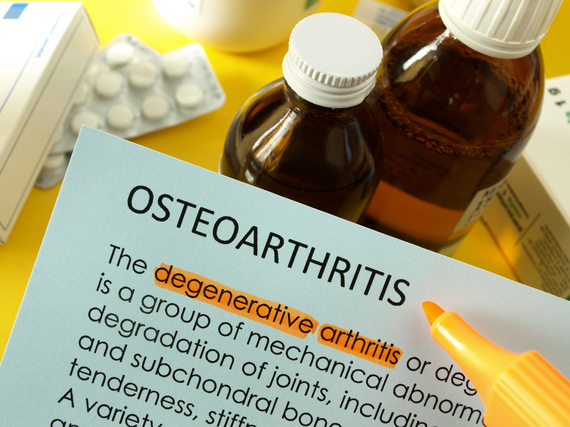
If you’ve been diagnosed with osteoarthritis, there’s a strong chance that you were advised to rest, limit your activities and use anti-inflammatory drugs to treat the symptoms of pain and inflammation. However, in our 25 years of treating people with osteoarthritis, we have learned that there are some major flaws in this advice.
Treatment Misconception: Rest
While you may find that resting your arthritic joint relieves the pain, too much rest actually causes the joint to become stiffer and lose its range of motion. When range of motion is lost, the joint will bear load on a smaller surface area and so will wear out even faster, just as when a car is out of alignment, the tires wear out faster.
Rest also de-conditions the muscles. Muscles absorb force around the joints and so when they are weak, the joint surfaces take up more of the load. Exercises that strengthen the muscles around your joints can protect the joint and reduce stress.
Exercising can keep you at a healthy weight; putting less impact on your joints and just as importantly, it can help maintain your good spirits. Time away from sports can increase depression [1] and since depression plays a huge role in how people feel about their limitations, it can compound the disease. Exercise stimulates the natural endorphins [2], adrenaline, testosterone and pheromones that promote healing and wellbeing.
Try a pool, a bike, Pilates, yoga or a gym. However, while exercising won’t wear out your joint, there may be a chance that a joint malalignment or other factors have contributed to your arthritis and so it is best to get the advice of a physical therapist or qualified trainer to see which exercises would be best for you.
Treatment Misconception: Anti-Inflammatory Drugs
Anti-inflammatory drugs work to reduce swelling and pain. They range from over-the-counter drugs like Advil or Motrin to stronger prescription brands. They are a godsend to many people suffering with arthritic symptoms. Yet the downsides must be managed as well. NSAIDs decrease collagen formation [3], leading to poor healing of soft tissue injuries and they inhibit bone formation leading to stress fractures [4]. Meanwhile, according to the American Gastroenterological Association, the serious side effects of NSAIDs, such as stomach bleeding, result in more than 100,000 hospitalizations and 16,500 deaths each year in the U.S. [5]
Additionally, when it comes to arthritis, NSAIDs can often exacerbate the problem by masking injuries that are sometimes fixable. A torn meniscus, for example, can lead to osteoarthritis, yet if it were treated, repaired or replaced it would diminish the arthritic damage that it produces in the joint [6]. Where possible, it’s best to address the cause of the arthritis by repairing the problem rather than taking painkillers to cover up the pain.
Some patients are able to improve their symptoms and cut down on their painkillers by taking supplements both orally such as glucosamine and injected such as hyaluronic acid. In our experience, they help a subset, not all, of patients with arthritis. Unfortunately we cannot tell in advance who will benefit, yet trial and error with these treatments has no known downside. In our practice about 30 percent of the patients are super responders to either glucosamine and or hyaluronic acid injections or get up to a year of relief from a single injection. Thirty percent of patient gets a mixed response and 30 percent seem to gain no benefit.
In summary, what I would advise would be to keep active, build your strength and try not to rely too heavily on anti-inflammatory drugs. Ask your doctor about the root cause of your osteoarthritis and investigate the options of getting it fixed. Arthritis is often treatable, maybe curable, and at the very least, should be more manageable for everyone.
REFERENCES:
1. Smith AM, Scott SG, O’Fallon WM, Young ML. Emotional responses of athletes to injury. Mayo Clin Proc. 1990;65(1):38-50.
2. Fraioli, F., et al. “Physical exercise stimulates marked concomitant release of β-endorphin and adrenocorticotropic hormone (ACTH) in peripheral blood in man.” Experientia 36.8 (1980): 987-989.
3. Ferry, Scott T., et al. “The effects of common anti-inflammatory drugs on the healing rat patellar tendon.” The American journal of sports medicine 35.8 (2007): 1326-1333.
4. Goodman, Stuart, et al. “COX‐2 selective NSAID decreases bone ingrowth in vivo.” Journal of Orthopaedic Research 20.6 (2002): 1164-1169.
5. Wolfe MM, Lichtenstein DR, Singh G. Gastrointestinal toxicity of nonsteroidal antiinflammatory drugs. N Engl J Med. 1999;340:1888-99.
6. Stone KR, Adelson WS, Pelsis JR, et al. 2010. Long-term survival of concurrent meniscus allograft transplantation and repair of the articular cartilage: A prospective 2-12 year follow-up report. J Bone Jt. Surg Br 92-B(7):941-948.
